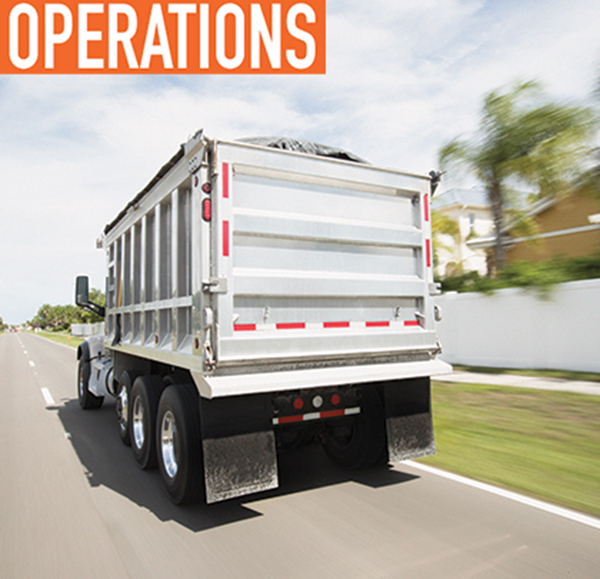When selecting a transmission for a new work truck, fleets often revisit the usual options: manuals, automated manuals, and fully automatics. While many owners think twice when it comes to the price of a fully automatic transmission, the total cost of ownership makes the choice easy. Their advantages can maximize a fleet’s bottom line in a number of ways.
PERFORMANCE AND PRODUCTIVITY
Fully automatic transmissions deliver smoother, seamless, full-power shifts and superior acceleration and startability. Each shift is made automatically when appropriate, allowing drivers to precisely manage performance and exercise superior vehicle control. This includes improved maneuverability to creep in soft soil and navigate tight spaces, as well as improved performance on hills with 2nd Reverse and more control on steep grades with virtually no rollback.
This type of performance is typically made possible by a torque converter that smoothly multiplies engine torque, delivering more power to the wheels. By multiplying engine power, drivers get increased performance, faster acceleration, and greater operational flexibility. Fully automatic transmissions eliminate power interrupts so trucks can accomplish more, even with a smaller engine.
With torque multiplication, fully automatic transmissions increase power while manual and automated manual transmissions (AMTs) lose power and torque with every shift. This results in inefficient operation and less ground traveled. Furthermore, manuals and AMTs do not benefit from torque multiplication because engine torque must be controlled or limited to extend the life of the starting clutch—which limits vehicle performance.
REDUCES MAINTENANCE COSTS
While a manual clutch pedal isn’t present in an AMT, a mechanical clutch still facilitates the vehicle’s launch. Like a manual transmission, this clutch will wear, eventually burn out, and need replacement. This means a vehicle spends more time being repaired and less time on the road.
Fully automatic transmissions with a torque converter experience very little wear and require only periodic fluid and filter changes to maintain peak performance. When maintenance is required, routine service allows a vehicle to get back on the road as soon as possible. With extended periods between maintenance, a fully automatic transmission is the best way to keep trucks on the road while reducing total cost of ownership.
In fact, fully automatic transmissions often offer prognostics that are fully calibrated to a vehicle’s particular operating requirements. The prognostics monitor various operating parameters to determine and alert when service is due. Prognostics take the guesswork and hassle out of scheduling routine vehicle maintenance. This eliminates unnecessary fluid and filter changes while providing maximum protection for the transmission.

Featured Image: Fully automatic transmissions can provide heavy-duty vehicles with Power Take-Off (PTO) for ease of operation.
Above: 1000/2000 Series Allison Transmission
IMPROVES FUEL ECONOMY
Fully automatic transmissions also offer increased fuel economy. Manuals and AMTs waste fuel and time getting up to speed while fully automatics offer the best combination of economy and productivity. In recent years, the introduction of fuel-saving technology has allowed fully automatic transmissions to get the most benefit out of every gallon of fuel.
For example, in 2014, Allison Transmission introduced FuelSense® software and electronic controls packages to increase fuel economy for a specific vehicle’s needs. Through a set of additional proprietary software enhancements, the company recently introduced FuelSense 2.0 technology with DynActive™ Shifting to provide an infinitely variable combination of shift points. The program uses a learning algorithm to continuously find the ideal balance of fuel economy and performance.
Providing the most value for applications with heavy start-stop needs, FuelSense 2.0 is best optimized for refuse, construction, and distribution applications. With more than three million test miles in customer fleets representing a variety of duty-cycles, the fleets have experienced fuel economy gains up to six percent.
The available packages are FuelSense 2.0, FuelSense 2.0 Plus, and FuelSense 2.0 Max. All three include DynActive Shifting. FuelSense 2.0 Plus and Max include improved Neutral at Stop. FuelSense 2.0 Max includes enhanced Acceleration Rate Management.
Improved Neutral at Stop: This feature lowers fuel consumption and emissions by reducing or eliminating the load on the engine when the vehicle is stopped. Two versions are available: (1) Standard: provides partial (first-level) Neutral at Stop, or (2) Premium: provides full Neutral at Stop and a new, low-speed coasting capability. Both versions feature a locked output at stop to prevent rollback.
Enhanced Acceleration Rate Management: This feature mitigates aggressive driving by automatically controlling engine torque. Newly updated, in addition to five levels of control currently available, it provides more precision by limiting vehicle acceleration to a customized rate.
HELPS WITH RECRUITING DRIVERS
Today’s drivers are less familiar with driving manual transmissions. This is not a problem with a fully automatic. Once behind the wheel of a fully automatic transmission-equipped vehicle, drivers are more alert and in tune with the vehicle, leading to increased driver retention and better safety records. Even experienced drivers benefit from more precise, safer handling, and improved comfort.
ENABLES POWER TAKE-OFF
Heavy-duty vehicles rely on hydraulic lifts and other auxiliary functions to get the job done. This equipment typically requires a Power Take-Off (PTO) to function and to deliver long-lasting power. Due to the heavy weights of a load, having a PTO that can be driven at engine speed is critical. Fully automatic transmissions can do this. A control module commands how and when the PTO engages and monitors operating conditions to minimize potential damage and hazards. This makes controlling the PTO much easier for drivers. They only have to push one button to activate or deactivate the PTO, allowing them to better focus on their tasks.
OFFERS BEST LIFECYCLE VALUE
When factoring in all lifecycle costs (vehicle purchase price, fuel, tires, preventive maintenance, component repair, driver wages, and retail resale value), a fully automatic transmission-equipped vehicle costs less to operate than a comparable competitively equipped vehicle. For reduced maintenance, increased fuel economy, increased productivity, and a bigger bottom line, fully automatics improve the way fleets works.
FOR MORE INFORMATION:
For more information about Allison Transmission, visit www.allisontransmission.com.
_______________________________________________________________________
MODERN WORKTRUCK SOLUTIONS: SEPTEMBER 2017 ISSUE
Did you enjoy this article?
Subscribe to the FREE Digital Edition of Modern WorkTruck Solutions magazine.
![]()




